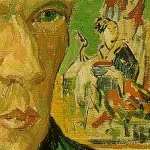
It was about this time last year that I arrived in Paris, on a cool, partly cloudy morning in early May, a Saturday as I recall. And one of the biggest national holiday weekends on the French calendar: the anniversary of the end of WW II. I felt grateful to find a cafe open for breakfast, to say nothing of the fact that my hotel hadn't lost my reservation, even if I couldn't yet occupy the room. When I finally did get into the room I dumped all my baggage: a large suitcase, a bag for my rather oversized laptop, and a backtop jammed to the hilt with books and guidebooks and maps and railway tickets and drawing pads and half a dozen other necessities. Then I reorganized, emptying my backpack of everything and then putting in only exactly what I needed for that day. I was sicking of lumbering around like a pack mule. You'd think I'd want to rest for a while, muzzy-brained as I was from a "night" spent on a transatlantic flight, which of course equals only a few hours of sleep. But I had only two days in Paris before I must leave for the south, and I knew my research itinerary was a full one. Besides, I was too wired to rest. I also knew the first place I needed and wanted to see: Montmartre, that famously bohemian district in the 18th arrondissement of Paris where Van Gogh lived for two years with his brother Theo, and where he first met a number of men who became crucially important to him, some personally and some professionally (and some both): Emile Bernard, Henri de Toulouse-Lautrec, Paul Signac, Paul Gauguin, Camille Pissarro, Pére Tanguy, Georges Seurat. (Just to name a few.) Arguably, the story of painting in the second half of the nineteenth century is the story of Montmartre, as it welcomed first the Impressionists and then the Neoimpressionists before either group found acceptance in larger society. It also where many of these painters lived, if not permanently then at least for a time.
To clarify: This would not be my first tour of Montmartre. The first time I even heard of the place was in 2001 when my family and I took a trip to Paris with a group of UCA students who were going on a "field trip" while studying in Maastricht in the Netherlands. We were joined on this Paris leg by my mother-in-law and a couple friends of hers. While my family and I toured many of the familiar spots of central Paris, my mother-in-law was "dragged" by her friends up the slope of Montmartre. To her, the area was nothing but a "big hill" with a bunch of people trying to hawk tacky wares. It didn't sound like I was missing anything at that time, so I hardly gave it a second thought. We were too busy hanging out at the playground in the Luxembourg Gardens; at the small, temporary amusement park established at the Tuileries; and at the Jardin d' Acclimatation in the Bois de Boulogne. When I returned to Paris in 2005, however, with the idea for Yellow firmly in mind, and armed with considerable knowledge about Van Gogh, I knew I had to go to Montmartre. It was a bright, gorgeous mid-summer day when we exited the Metro and made out way, among crowds of other tourists, to the area. To say the least, what I found hardly matched my mother-in-law's description. Yes, of course, Montmartre is essentially one high, large hill, around which a variety of streets wend. But oh what a great hill.
What one can't not notice upon arriving in Montmartre is the stunning white church that sits at the top: the Basilique du Sacré-Cœur. The marble on the church, which has become the symbol of the district, literally shines. Although the construction of the church was not completed until long after Van Gogh's death--and thus it has no connection to either him or the artistic community he played a role in--one cannot visit Montmarte for the first time without stopping in. Or at least I thought so. While my wife waited with our two sons on the broad courtyard outside, and bought a great and possibly illegal purse from one of those nasty "hawkers," I walked up the towering church stairs, enjoyed the incredible view of Paris afforded from there, and then went inside. The transition from the bright sunshine outside was rather drastic but I felt rewarded by the lavish interior.
Done with the church we headed down the hill a bit and then westward along the Rue des Abbesses, picking up sandwiches at one of the many streetside eateries. Our rather overactive, overgrabby young boys earned a disapproving look from one restaurant employee who murmured to the woman next to him something unkind about the English. I chose not to disabuse him of his false identification, but smiled upon receiving our sandwiches and wished him a good day.
Next post's: Discovering Van Gogh hideouts













0 comments:
Post a Comment